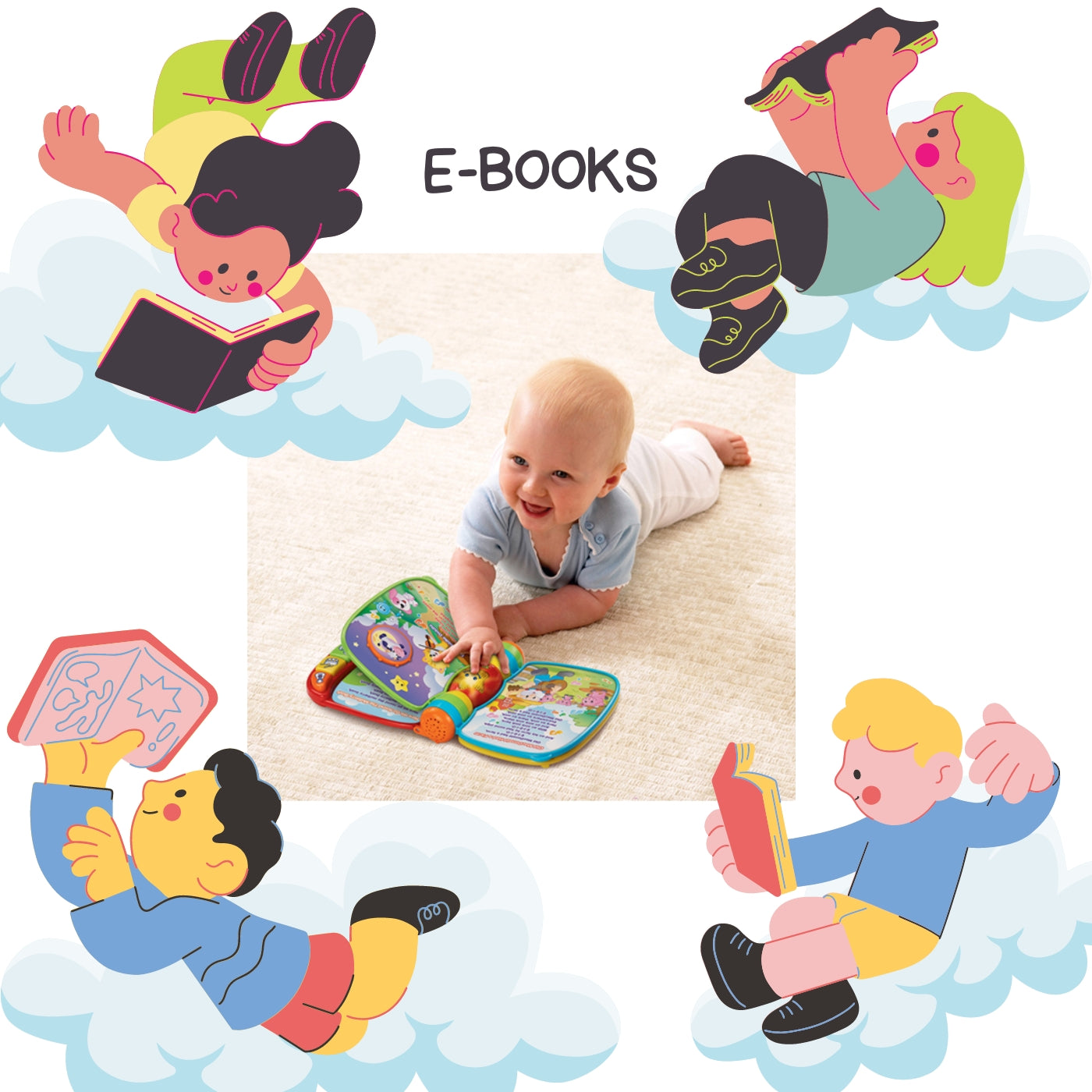
Gone are the days when traditional books were the only means of learning for children. In today's digital age, interactive e-books have taken over the market, providing a new and exciting way for children to learn. With the rise of technology, the use of interactive e-books has revolutionized the education industry in countless ways. Interactive e-books are designed to engage children with visual and auditory features, helping them to learn and retain information more effectively. They are also an excellent tool for parents and teachers to help children develop their language skills, improve their reading comprehension, and expand their overall knowledge. In this blog post, we will explore the many benefits of using interactive e-books for children and how they are changing the way we educate our kids.
1. The evolution of children's books
Children's books have come a long way since the first illustrated children's book was published in the 15th century. Over the years, children's books have evolved to include more interactive elements such as pop-ups, lift-the-flaps, and touch-and-feel features, making reading a more engaging experience for children.
In recent years, the introduction of e-books has taken the evolution of children's books to a whole new level. Interactive e-books now offer children a highly engaging and immersive experience with features such as animations, games, narration, and music. These e-books are designed to not only entertain but also educate children, making learning fun and exciting.
Interactive e-books have also made reading more accessible to children, especially those with learning challenges. Children with dyslexia, for example, can benefit from e-books that offer dyslexia-friendly fonts, text-to-speech, and other features that make reading easier and more enjoyable.
Another advantage of interactive e-books is that they can be easily updated with new content, ensuring that children always have access to the latest information and stories. This makes learning more relevant and interesting for children, as they can explore new subjects and topics with ease.
Overall, the evolution of children's books has been driven by a desire to make learning fun and engaging for children. Interactive e-books are the latest chapter in this evolution, offering children a highly interactive and immersive learning experience that is sure to revolutionize the way children learn and absorb information.
2. Introducing interactive e-books for children
Interactive e-books for children are a powerful learning tool that is revolutionizing the way children learn. With interactive e-books, children are able to engage with stories, characters, and concepts in a whole new way. Text, images, and audio are combined to create an immersive experience that can capture the attention of even the most reluctant readers.
Interactive e-books can also help children learn in a more personalized way. They can choose their own path through a story, interact with characters and environments, and engage with educational games and activities that are built into the e-book. This type of learning is not only effective, but it%u2019s also fun, which can help to instill a love of reading and learning in children from a young age.
Another great feature of interactive e-books is that they are accessible to children everywhere. With more and more children having access to devices like tablets and smartphones, interactive e-books can be easily downloaded and used by children, regardless of their location or socio-economic background.
Overall, interactive e-books are an exciting development in the world of children's learning. They offer a fun and engaging way for children to learn, while also being accessible and personalized. As technology continues to evolve, we can expect to see even more innovative ways in which interactive e-books will revolutionize the way that children learn.
3. How interactive e-books are revolutionizing learning
Interactive e-books are revolutionizing the way children approach learning by providing a dynamic and engaging educational experience. Unlike traditional books, interactive e-books incorporate multimedia elements such as audio, video, and interactive games, which enhance the learning experience and make it more interactive.
One of the biggest advantages of interactive e-books is that they cater to different learning styles. For instance, children who prefer visual learning can watch videos or view images, while those who prefer auditory learning can listen to audio clips. Interactive e-books also include interactive games and quizzes that help children to test their knowledge and reinforce key concepts.
Another advantage of interactive e-books is that they can be personalized to meet the needs of individual learners. For example, children who are struggling with a particular concept can receive targeted feedback and additional resources to help them master the material.
Interactive e-books also make learning fun and enjoyable. By incorporating game-like elements, children are motivated to learn and engage with the material. This can help to foster a lifelong love of learning and encourage children to explore new topics and ideas.
Overall, interactive e-books represent a powerful tool for revolutionizing learning and providing children with an engaging and dynamic educational experience that is tailored to their individual needs and preferences.
4. The benefits of interactive e-books for children's learning
Interactive e-books are revolutionizing the way children learn and read. In contrast to traditional print books, interactive e-books offer a wide range of benefits that make learning more engaging and effective for children.
One major benefit of interactive e-books is that they offer multimedia features, such as animations, videos, and interactive games that can enhance the learning experience for children. These features can help children to better understand the content and concepts being taught, making the learning process more engaging and enjoyable.
In addition, interactive e-books can also help to improve children's reading skills. With features such as read-aloud functionality and interactive text highlighting, children can follow along with the story and improve their reading comprehension.
Interactive e-books also provide opportunities for children to learn at their own pace. With features such as interactive quizzes and puzzles, children can review and reinforce their understanding of the content in a fun and engaging way.
Another benefit of interactive e-books is that they can be customized to meet the needs of different learners. For example, children with learning disabilities can benefit from features such as adjustable font sizes, text-to-speech capabilities, and dyslexia-friendly fonts.
Overall, interactive e-books offer a range of benefits that can improve children's learning and reading skills, making them an excellent tool for parents and educators to use in promoting children's education and development.
5. Interactive e-books versus traditional books
Interactive e-books have become increasingly popular in recent years, especially for children's learning. One of the main advantages of interactive e-books is that they offer a more engaging and immersive experience compared to traditional books.
Children can interact with the content through touch, sound, and even animations, which can help to keep them focused and interested in the subject matter. Interactive e-books also have the advantage of being able to incorporate multimedia elements such as videos and audio, which can add another layer of learning and entertainment.
Another advantage of interactive e-books is that they can be updated easily to reflect new information or changes in subject matter. This is especially important for educational content, where information is constantly evolving.
On the other hand, traditional books have their own benefits. For example, they don't require any technology, and they can be read anywhere, anytime, without the need for an electronic device or an internet connection. Some people also argue that reading from a physical book can be easier on the eyes and less distracting than reading from a screen.
Ultimately, the choice between interactive e-books and traditional books will depend on individual preferences and circumstances. However, it's clear that interactive e-books offer a unique and exciting way to learn and engage with content, making them a valuable tool for children's education.
6. The role of technology in education
In today's day and age, technology has become an integral part of our daily lives. It has revolutionized many industries, and education is no exception. Technology has transformed the way we learn and has made education more accessible and engaging for students of all ages.
Interactive e-books are a prime example of how technology can be used to enhance the learning experience. These e-books are designed to be highly engaging, with interactive graphics, animations, and even 3D models that bring the content to life.
Moreover, the use of technology has allowed for personalized learning experiences. Interactive e-books can be tailored to meet the unique needs of individual students, with quizzes, assessments, and interactive exercises that help reinforce concepts.
Technology has also made education more accessible. With the rise of e-learning platforms, students can now access educational resources from anywhere in the world. This has opened up opportunities for students who may not have had access to quality education before.
Overall, the role of technology in education cannot be overstated. It has transformed the way we learn and has made education more engaging, personalized, and accessible than ever before. Interactive e-books are just one example of how technology can be used to revolutionize learning, and we can expect to see many more innovative solutions in the future.
7. How interactive e-books can be used in the classroom
Interactive e-books are a great tool for teachers to use in the classroom. They can be used to supplement classroom learning, engage students in new ways, and help students understand complex concepts. Here are a few ways that interactive e-books can be used in the classroom:
1. Differentiated instruction: Interactive e-books can be used to provide differentiated instruction to students of varying levels. For example, students who are struggling with reading can use the audio feature to listen to the book while following along with the text. Meanwhile, advanced readers can use the interactive features to explore the book's content in greater depth.
2. Engaging and interactive learning: Interactive e-books can be used to engage students in new and creative ways. For example, students can interact with characters in the book, solve puzzles and quizzes, and explore multimedia features like videos and audio recordings.
3. Assessment: Interactive e-books can be used as an assessment tool to evaluate student learning. For example, teachers can use the analytics provided by the e-book platform to track student progress and identify areas where students may need additional support.
Overall, interactive e-books have the potential to revolutionize learning in the classroom. By providing engaging and interactive content, teachers can create a more dynamic learning environment that helps students understand complex concepts and enjoy the learning process.
8. The future of interactive e-books in education
Interactive e-books have revolutionized the way we learn and have opened up new ways of engaging children in the educational process. As technology continues to advance, the future of interactive e-books in education is very exciting.
Interactive e-books have the potential to provide children with a more personalized learning experience. By tracking their progress, these e-books can adapt to the child's pace, offering more challenging tasks when they are ready for them and providing additional support when they need it.
Another exciting aspect of interactive e-books is the ability to incorporate multimedia elements, such as audio and video, to further engage children in the learning process. This can be especially beneficial for children who may struggle with traditional learning methods or who have different learning styles.
In addition, interactive e-books can provide a wealth of data that can be used by educators to improve teaching methods and tailor lessons to better meet the needs of their students. As technology continues to evolve, the possibilities for interactive e-books in education are endless, and we are excited to see how this innovative technology will continue to shape the future of learning.
9. Potential drawbacks of interactive e-books
While interactive e-books for children have their advantages, there are also potential drawbacks that parents and educators should consider.
One major concern is the potential for overstimulation. With interactive features such as animations, videos, and sound effects, children may become too focused on the technology and lose sight of the actual story or lesson being taught. This can lead to a lack of engagement and comprehension.
Another issue is the potential for distraction. With the internet at their fingertips, children may be tempted to click away from the e-book and explore other websites or apps, hindering their learning and wasting time.
Furthermore, some experts argue that reading on a screen may not be as effective as reading from a physical book in terms of memory retention and comprehension.
Lastly, the cost of interactive e-books can also be a concern for families and schools, as they typically come with a higher price tag compared to traditional books.
It's important for parents and educators to weigh the pros and cons of interactive e-books before incorporating them into children's learning experiences. While they can be a valuable tool for engagement and learning, it's important to be mindful of their potential drawbacks and use them in moderation.
10. Conclusion: The power of interactive e-books for children's learning
In conclusion, interactive e-books are revolutionizing the way children learn. They provide a more engaging and immersive learning experience that can help children retain information better. Interactive e-books offer a plethora of benefits, including interactive elements, multimedia content, and personalized feedback, which traditional printed books cannot match.
The use of interactive e-books as a learning tool is especially relevant in today's digital age, where children are more exposed to technology than ever before. Interactive e-books offer a way to bridge the gap between technology and education, making learning more accessible and enjoyable.
Interactive e-books are not only beneficial for children's learning but also for parents and educators. Parents can use them as a tool to enhance their child's learning experience at home, while educators can use them in the classroom to create a more engaging and interactive learning environmen.
Overall, the power of interactive e-books for children's learning should not be underestimated. They are a valuable tool in the world of education and have the potential to transform the way we teach and learn. As technology continues to advance, we can expect to see even more innovative and exciting interactive e-books in the future.

